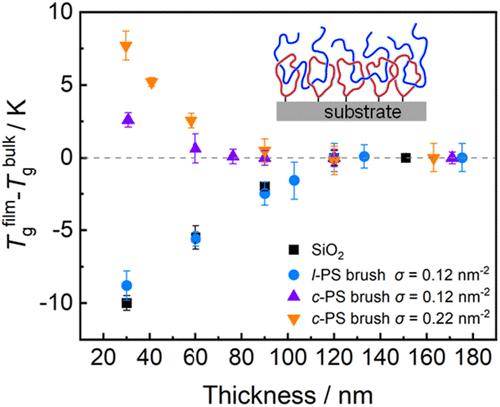通过线性-循环穿线行为增强循环PS刷支撑的PS薄膜中抑制的片段迁移率
IF 5.2
1区 化学
Q1 POLYMER SCIENCE
引用次数: 0
摘要
聚合物薄膜中由界面链构象介导的链迁移引起了广泛的关注,但其机制尚不清楚。本文通过调节环(c-)聚苯乙烯(PS)刷在衬底上的接枝密度(σ),探讨其对复盖PS薄膜玻璃化转变温度(Tg)的影响。结果表明,与线性刷相比,在σ≤0.22 nm-2的c-PS刷上负载的PS膜的节段迁移率受到了很大的抑制。当σ >; 0.31 nm-2时,负载PS膜的Tg随σ的增大而减小,且小于其体Tg。PS薄膜中抑制片段迁移率的增强归因于PS薄膜中的自由链和界面处的c-PS刷的线性循环穿线行为。当σ较低时,薄膜中的PS链在循环刷中被螺纹缠绕,其迁移率受到很大的抑制。然而,在较高的σ下,PS链很难穿过c-PS刷,聚合物熔体被熵效应从聚合物刷中排出,导致PS刷的拓扑结构对上部PS膜的Tg没有影响。本研究表明,通过c-聚合物刷锚定在薄膜上的上层自由链的穿线行为可以提高薄膜的Tg,为提高超薄聚合物薄膜的热稳定性提供了一种新的方法,并揭示了吸附链的作用机制,其中自由链穿过基体上吸附链的“环”会影响薄膜中的链迁移率。本文章由计算机程序翻译,如有差异,请以英文原文为准。

Enhancement of Suppressed Segmental Mobility in Thin PS Films Supported on Cyclic PS Brushes by Linear-Cyclic Threading Behavior
The chain mobility in thin polymer film mediated by interfacial chain conformations has attracted much attention over the past decades, but its mechanism is still unclear. In this paper, we modulated the grafting density (σ) of cyclic (c-) polystyrene (PS) brushes on their substrate to probe their effect on the glass transition temperature (Tg) in overlaying PS thin films. The results show that the segmental mobility of PS films supported on c-PS brushes with σ ≤ 0.22 nm–2 was greatly suppressed compared with that on linear brushes. When σ > 0.31 nm–2, the Tg of the supported PS film decreased with the increase of σ and was lower than that of its bulk Tg. The enhanced suppressed segmental mobility in thin PS films was attributed to the linear-cyclic threading behavior occurring in free chains in the PS film and c-PS brushes at the interface. When σ was relatively low, the PS chains in the film were threaded through cyclic brushes and their mobility was greatly suppressed. However, the PS chains were difficult to thread through the c-PS brushes at relatively high σ and the polymer melts were expelled from the polymer brushes by entropic effects, resulting in a topology of the PS brushes that had no effect on the Tg of the upper PS film. This work demonstrated that the Tg of thin polymers films could be enhanced through the threading behavior of upper free chains with c-polymer brushes anchored on their substrate, providing a novel method to improve the thermal stability of ultrathin polymer films and revealing the mechanism of the effect of adsorbed chains in which the chain mobility in the film should be affected by the threading of the free chains through the “loops” in adsorbed chains on the substrate.
求助全文
通过发布文献求助,成功后即可免费获取论文全文。
去求助
来源期刊

Macromolecules
工程技术-高分子科学
CiteScore
9.30
自引率
16.40%
发文量
942
审稿时长
2 months
期刊介绍:
Macromolecules publishes original, fundamental, and impactful research on all aspects of polymer science. Topics of interest include synthesis (e.g., controlled polymerizations, polymerization catalysis, post polymerization modification, new monomer structures and polymer architectures, and polymerization mechanisms/kinetics analysis); phase behavior, thermodynamics, dynamic, and ordering/disordering phenomena (e.g., self-assembly, gelation, crystallization, solution/melt/solid-state characteristics); structure and properties (e.g., mechanical and rheological properties, surface/interfacial characteristics, electronic and transport properties); new state of the art characterization (e.g., spectroscopy, scattering, microscopy, rheology), simulation (e.g., Monte Carlo, molecular dynamics, multi-scale/coarse-grained modeling), and theoretical methods. Renewable/sustainable polymers, polymer networks, responsive polymers, electro-, magneto- and opto-active macromolecules, inorganic polymers, charge-transporting polymers (ion-containing, semiconducting, and conducting), nanostructured polymers, and polymer composites are also of interest. Typical papers published in Macromolecules showcase important and innovative concepts, experimental methods/observations, and theoretical/computational approaches that demonstrate a fundamental advance in the understanding of polymers.
 求助内容:
求助内容: 应助结果提醒方式:
应助结果提醒方式:


